MN Masters of Teaching: 5E Lesson Plan on Living vs. Non-living Things
VerifiedAdded on 2022/10/11
|11
|3168
|18
Homework Assignment
AI Summary
This assignment presents a detailed 5E lesson plan designed for early childhood education, specifically for 5-year-olds, focusing on distinguishing between living and non-living things. The lesson plan is structured around the 5E model: Engage, Explore, Explain, Elaborate, and Evaluate. The topic chosen is biological science, with a sequence of five lessons. The plan includes national curriculum concepts, learning objectives, and activities such as experiments, discussions, and observations. The 'Engage' phase involves assessing prior knowledge and sparking interest, while 'Explore' uses books, videos, and outdoor activities to introduce new concepts. The 'Explain' phase clarifies the differences between living and non-living things. 'Elaborate' allows students to apply their knowledge through activities, and 'Evaluate' assesses their understanding through tests and observations. The plan also incorporates adaptations for students with special needs and includes an overall unit plan evaluation based on the BSCS 5E instructional model. The assignment also refers to the PrimaryConnections program.
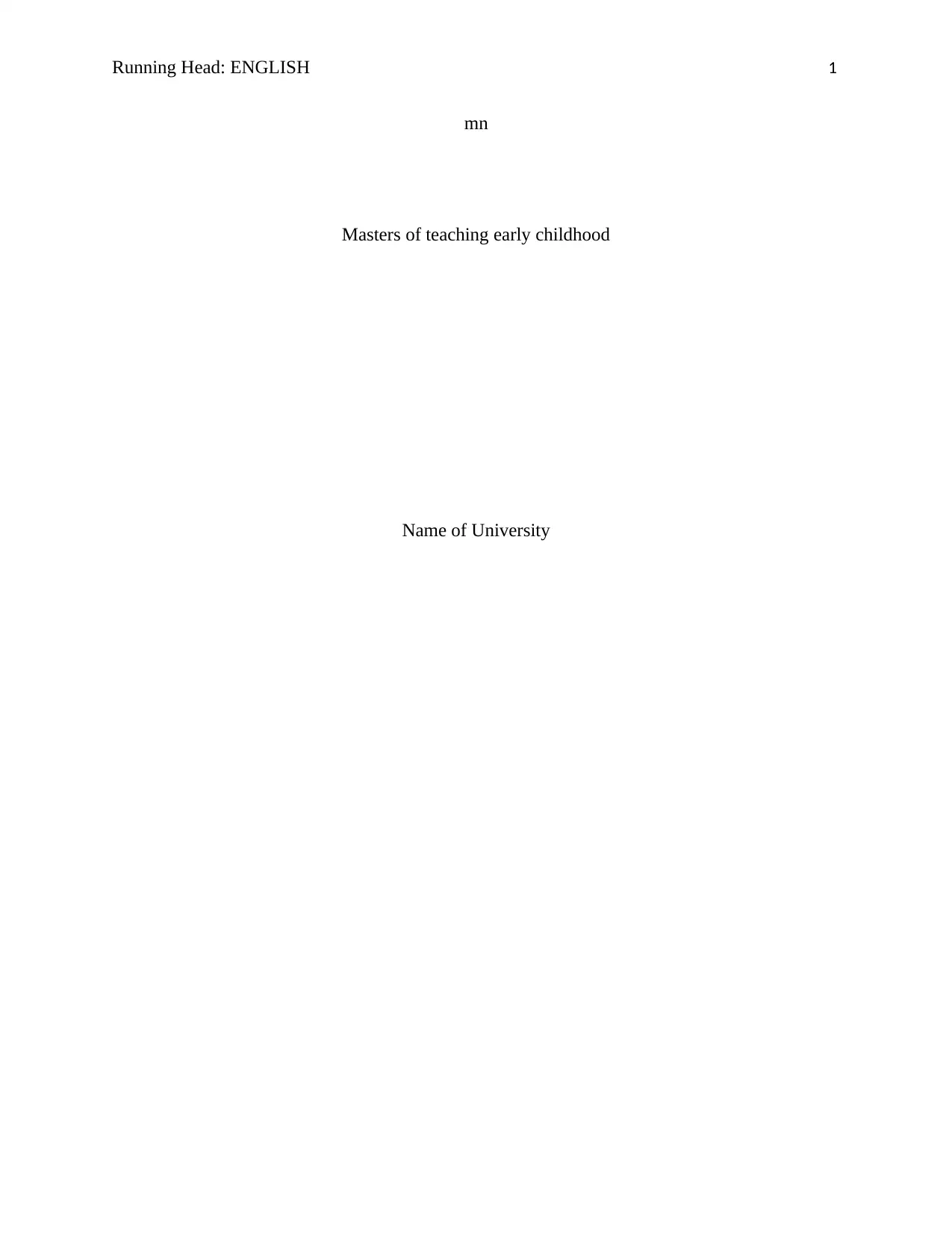
Running Head: ENGLISH 1
mn
Masters of teaching early childhood
Name of University
mn
Masters of teaching early childhood
Name of University
Paraphrase This Document
Need a fresh take? Get an instant paraphrase of this document with our AI Paraphraser
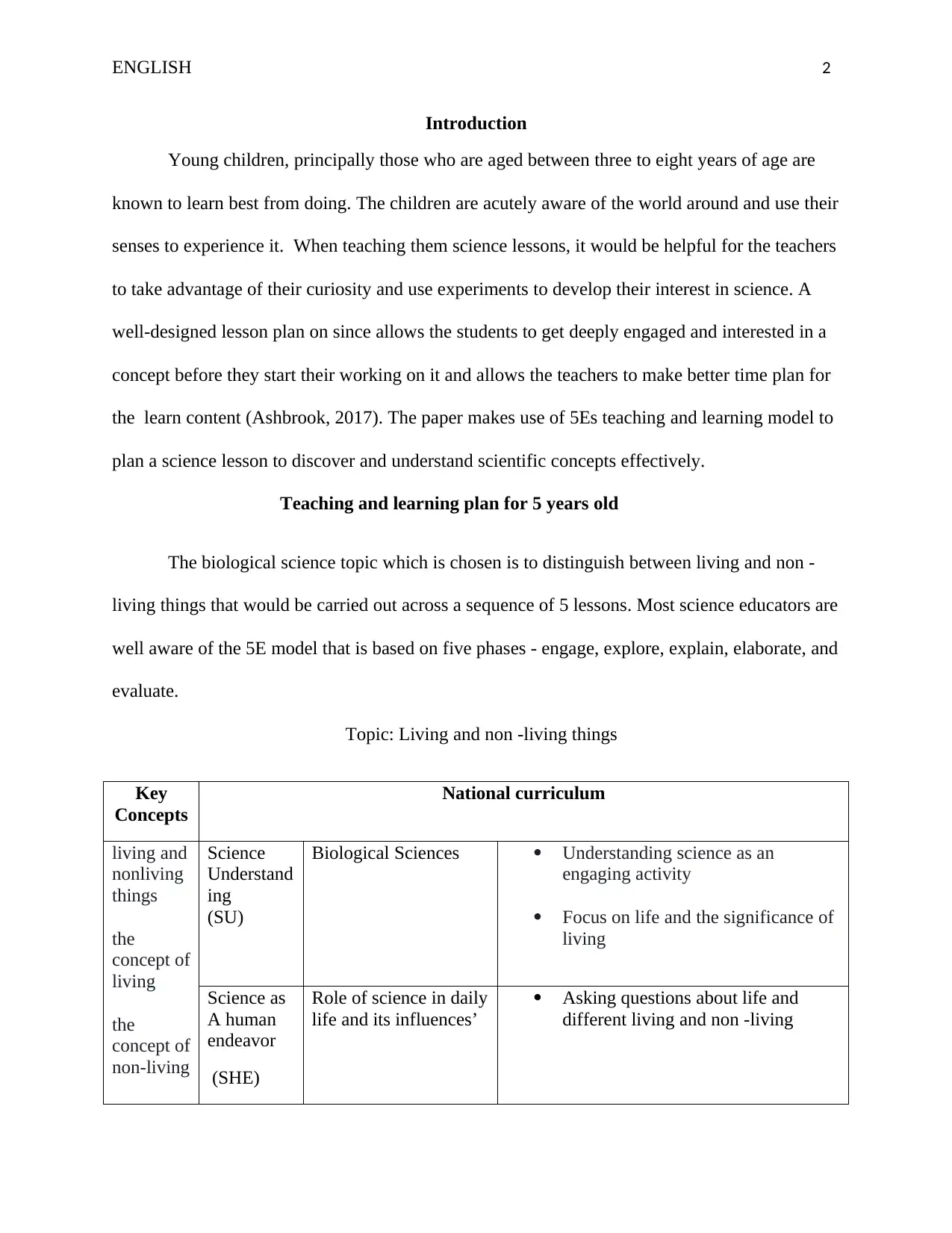
ENGLISH 2
Introduction
Young children, principally those who are aged between three to eight years of age are
known to learn best from doing. The children are acutely aware of the world around and use their
senses to experience it. When teaching them science lessons, it would be helpful for the teachers
to take advantage of their curiosity and use experiments to develop their interest in science. A
well-designed lesson plan on since allows the students to get deeply engaged and interested in a
concept before they start their working on it and allows the teachers to make better time plan for
the learn content (Ashbrook, 2017). The paper makes use of 5Es teaching and learning model to
plan a science lesson to discover and understand scientific concepts effectively.
Teaching and learning plan for 5 years old
The biological science topic which is chosen is to distinguish between living and non -
living things that would be carried out across a sequence of 5 lessons. Most science educators are
well aware of the 5E model that is based on five phases - engage, explore, explain, elaborate, and
evaluate.
Topic: Living and non -living things
Key
Concepts
National curriculum
living and
nonliving
things
the
concept of
living
the
concept of
non-living
Science
Understand
ing
(SU)
Biological Sciences Understanding science as an
engaging activity
Focus on life and the significance of
living
Science as
A human
endeavor
(SHE)
Role of science in daily
life and its influences’
Asking questions about life and
different living and non -living
Introduction
Young children, principally those who are aged between three to eight years of age are
known to learn best from doing. The children are acutely aware of the world around and use their
senses to experience it. When teaching them science lessons, it would be helpful for the teachers
to take advantage of their curiosity and use experiments to develop their interest in science. A
well-designed lesson plan on since allows the students to get deeply engaged and interested in a
concept before they start their working on it and allows the teachers to make better time plan for
the learn content (Ashbrook, 2017). The paper makes use of 5Es teaching and learning model to
plan a science lesson to discover and understand scientific concepts effectively.
Teaching and learning plan for 5 years old
The biological science topic which is chosen is to distinguish between living and non -
living things that would be carried out across a sequence of 5 lessons. Most science educators are
well aware of the 5E model that is based on five phases - engage, explore, explain, elaborate, and
evaluate.
Topic: Living and non -living things
Key
Concepts
National curriculum
living and
nonliving
things
the
concept of
living
the
concept of
non-living
Science
Understand
ing
(SU)
Biological Sciences Understanding science as an
engaging activity
Focus on life and the significance of
living
Science as
A human
endeavor
(SHE)
Role of science in daily
life and its influences’
Asking questions about life and
different living and non -living
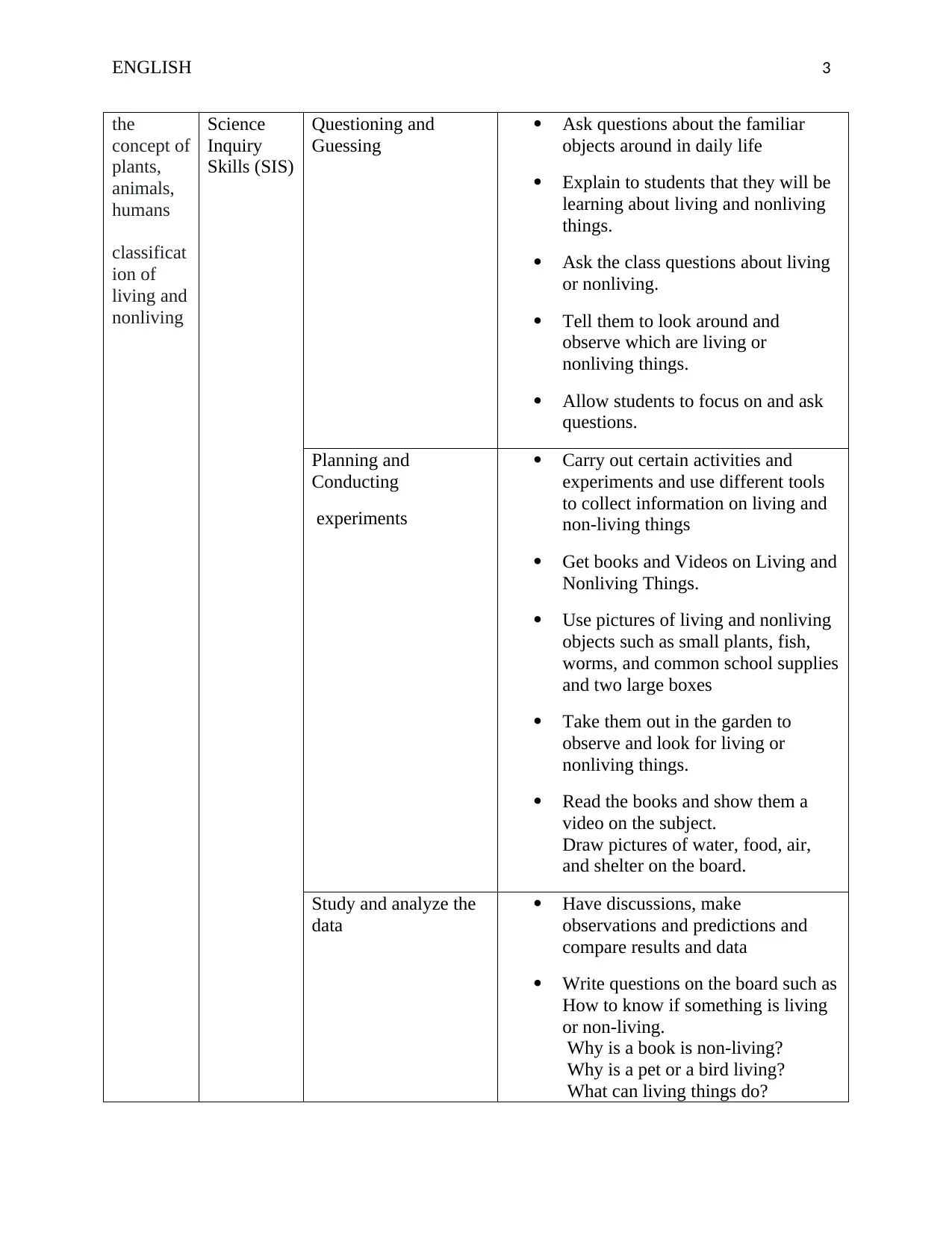
ENGLISH 3
the
concept of
plants,
animals,
humans
classificat
ion of
living and
nonliving
Science
Inquiry
Skills (SIS)
Questioning and
Guessing
Ask questions about the familiar
objects around in daily life
Explain to students that they will be
learning about living and nonliving
things.
Ask the class questions about living
or nonliving.
Tell them to look around and
observe which are living or
nonliving things.
Allow students to focus on and ask
questions.
Planning and
Conducting
experiments
Carry out certain activities and
experiments and use different tools
to collect information on living and
non-living things
Get books and Videos on Living and
Nonliving Things.
Use pictures of living and nonliving
objects such as small plants, fish,
worms, and common school supplies
and two large boxes
Take them out in the garden to
observe and look for living or
nonliving things.
Read the books and show them a
video on the subject.
Draw pictures of water, food, air,
and shelter on the board.
Study and analyze the
data
Have discussions, make
observations and predictions and
compare results and data
Write questions on the board such as
How to know if something is living
or non-living.
Why is a book is non-living?
Why is a pet or a bird living?
What can living things do?
the
concept of
plants,
animals,
humans
classificat
ion of
living and
nonliving
Science
Inquiry
Skills (SIS)
Questioning and
Guessing
Ask questions about the familiar
objects around in daily life
Explain to students that they will be
learning about living and nonliving
things.
Ask the class questions about living
or nonliving.
Tell them to look around and
observe which are living or
nonliving things.
Allow students to focus on and ask
questions.
Planning and
Conducting
experiments
Carry out certain activities and
experiments and use different tools
to collect information on living and
non-living things
Get books and Videos on Living and
Nonliving Things.
Use pictures of living and nonliving
objects such as small plants, fish,
worms, and common school supplies
and two large boxes
Take them out in the garden to
observe and look for living or
nonliving things.
Read the books and show them a
video on the subject.
Draw pictures of water, food, air,
and shelter on the board.
Study and analyze the
data
Have discussions, make
observations and predictions and
compare results and data
Write questions on the board such as
How to know if something is living
or non-living.
Why is a book is non-living?
Why is a pet or a bird living?
What can living things do?
⊘ This is a preview!⊘
Do you want full access?
Subscribe today to unlock all pages.

Trusted by 1+ million students worldwide
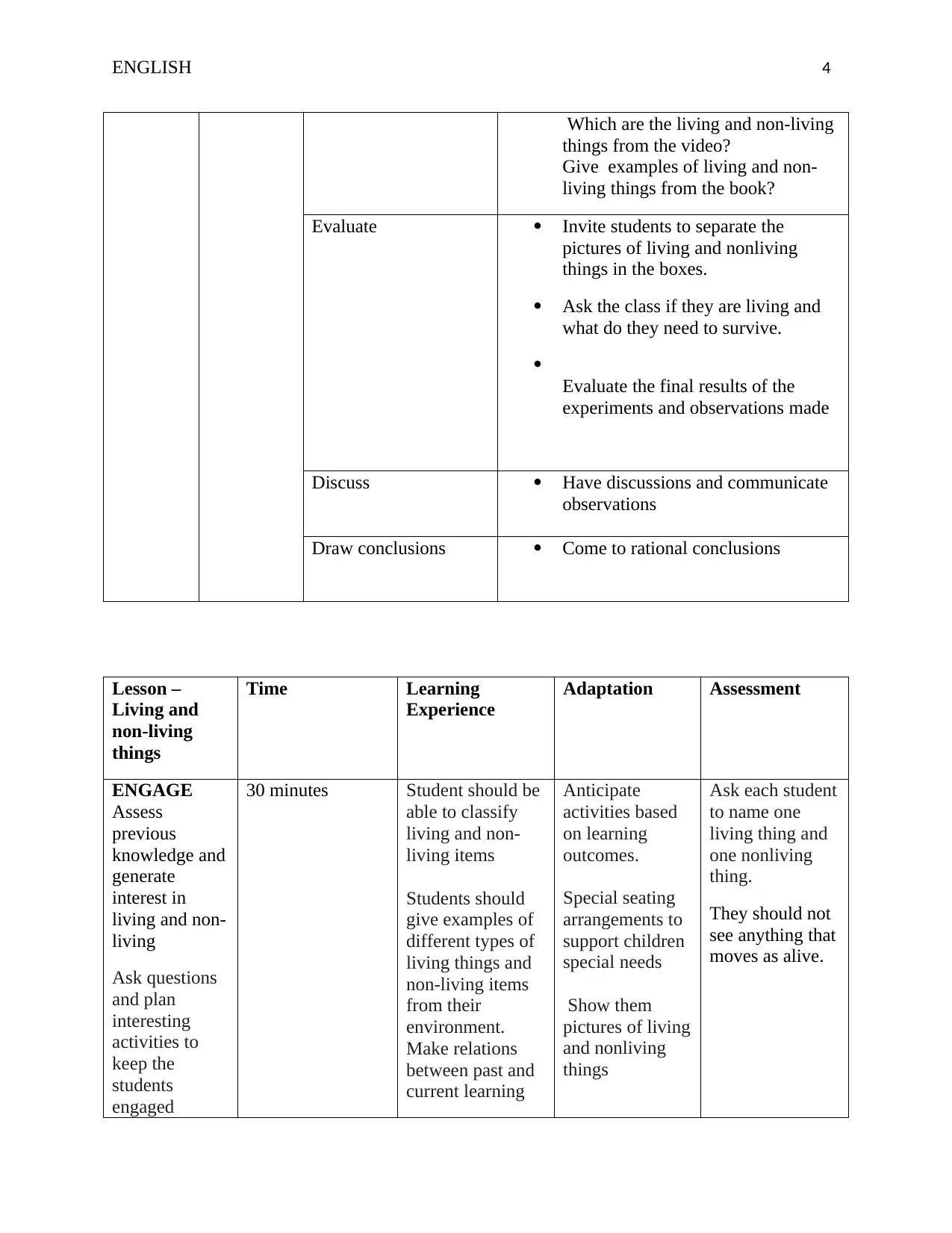
ENGLISH 4
Which are the living and non-living
things from the video?
Give examples of living and non-
living things from the book?
Evaluate Invite students to separate the
pictures of living and nonliving
things in the boxes.
Ask the class if they are living and
what do they need to survive.
Evaluate the final results of the
experiments and observations made
Discuss Have discussions and communicate
observations
Draw conclusions Come to rational conclusions
Lesson –
Living and
non-living
things
Time Learning
Experience
Adaptation Assessment
ENGAGE
Assess
previous
knowledge and
generate
interest in
living and non-
living
Ask questions
and plan
interesting
activities to
keep the
students
engaged
30 minutes Student should be
able to classify
living and non-
living items
Students should
give examples of
different types of
living things and
non-living items
from their
environment.
Make relations
between past and
current learning
Anticipate
activities based
on learning
outcomes.
Special seating
arrangements to
support children
special needs
Show them
pictures of living
and nonliving
things
Ask each student
to name one
living thing and
one nonliving
thing.
They should not
see anything that
moves as alive.
Which are the living and non-living
things from the video?
Give examples of living and non-
living things from the book?
Evaluate Invite students to separate the
pictures of living and nonliving
things in the boxes.
Ask the class if they are living and
what do they need to survive.
Evaluate the final results of the
experiments and observations made
Discuss Have discussions and communicate
observations
Draw conclusions Come to rational conclusions
Lesson –
Living and
non-living
things
Time Learning
Experience
Adaptation Assessment
ENGAGE
Assess
previous
knowledge and
generate
interest in
living and non-
living
Ask questions
and plan
interesting
activities to
keep the
students
engaged
30 minutes Student should be
able to classify
living and non-
living items
Students should
give examples of
different types of
living things and
non-living items
from their
environment.
Make relations
between past and
current learning
Anticipate
activities based
on learning
outcomes.
Special seating
arrangements to
support children
special needs
Show them
pictures of living
and nonliving
things
Ask each student
to name one
living thing and
one nonliving
thing.
They should not
see anything that
moves as alive.
Paraphrase This Document
Need a fresh take? Get an instant paraphrase of this document with our AI Paraphraser
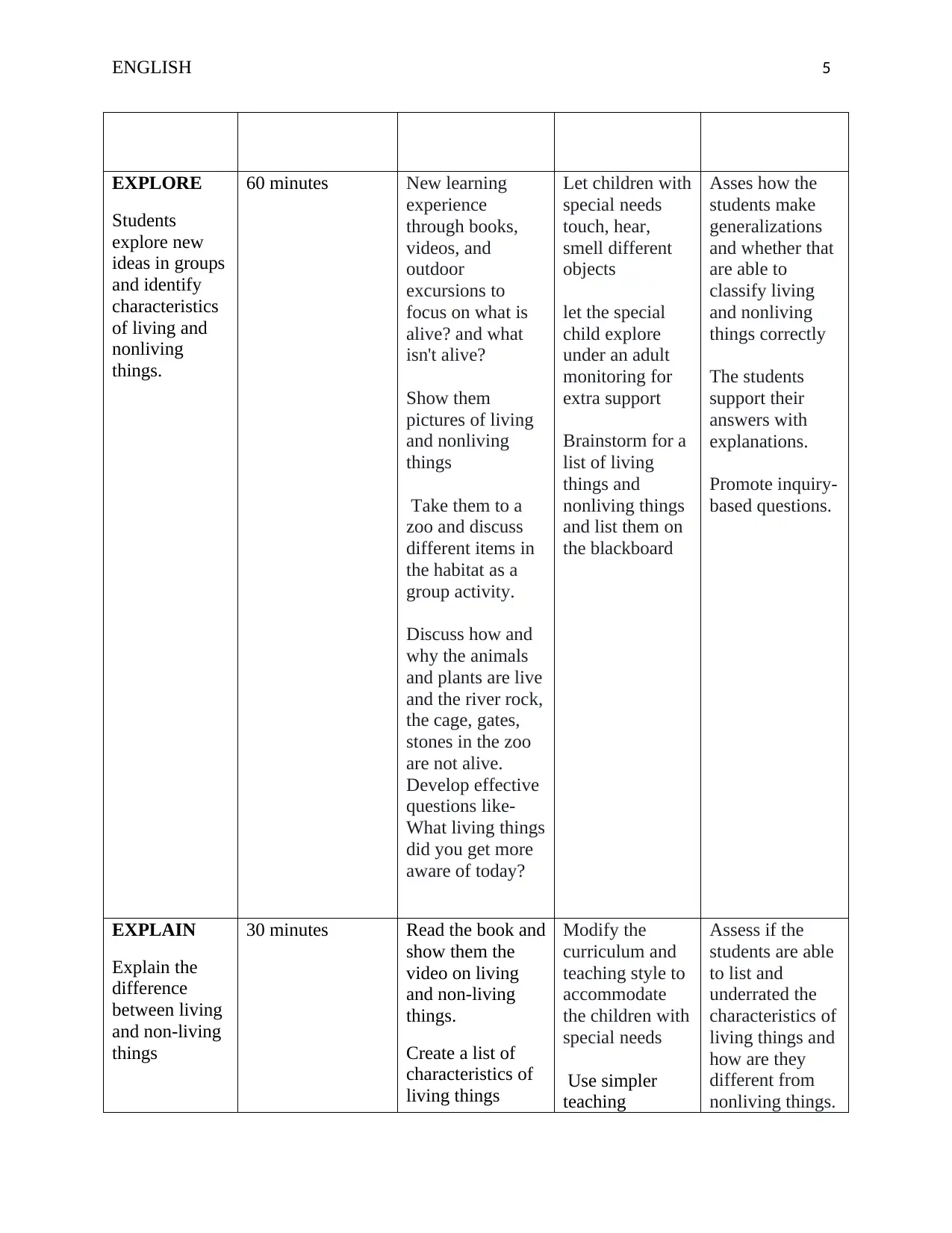
ENGLISH 5
EXPLORE
Students
explore new
ideas in groups
and identify
characteristics
of living and
nonliving
things.
60 minutes New learning
experience
through books,
videos, and
outdoor
excursions to
focus on what is
alive? and what
isn't alive?
Show them
pictures of living
and nonliving
things
Take them to a
zoo and discuss
different items in
the habitat as a
group activity.
Discuss how and
why the animals
and plants are live
and the river rock,
the cage, gates,
stones in the zoo
are not alive.
Develop effective
questions like-
What living things
did you get more
aware of today?
Let children with
special needs
touch, hear,
smell different
objects
let the special
child explore
under an adult
monitoring for
extra support
Brainstorm for a
list of living
things and
nonliving things
and list them on
the blackboard
Asses how the
students make
generalizations
and whether that
are able to
classify living
and nonliving
things correctly
The students
support their
answers with
explanations.
Promote inquiry-
based questions.
EXPLAIN
Explain the
difference
between living
and non-living
things
30 minutes Read the book and
show them the
video on living
and non-living
things.
Create a list of
characteristics of
living things
Modify the
curriculum and
teaching style to
accommodate
the children with
special needs
Use simpler
teaching
Assess if the
students are able
to list and
underrated the
characteristics of
living things and
how are they
different from
nonliving things.
EXPLORE
Students
explore new
ideas in groups
and identify
characteristics
of living and
nonliving
things.
60 minutes New learning
experience
through books,
videos, and
outdoor
excursions to
focus on what is
alive? and what
isn't alive?
Show them
pictures of living
and nonliving
things
Take them to a
zoo and discuss
different items in
the habitat as a
group activity.
Discuss how and
why the animals
and plants are live
and the river rock,
the cage, gates,
stones in the zoo
are not alive.
Develop effective
questions like-
What living things
did you get more
aware of today?
Let children with
special needs
touch, hear,
smell different
objects
let the special
child explore
under an adult
monitoring for
extra support
Brainstorm for a
list of living
things and
nonliving things
and list them on
the blackboard
Asses how the
students make
generalizations
and whether that
are able to
classify living
and nonliving
things correctly
The students
support their
answers with
explanations.
Promote inquiry-
based questions.
EXPLAIN
Explain the
difference
between living
and non-living
things
30 minutes Read the book and
show them the
video on living
and non-living
things.
Create a list of
characteristics of
living things
Modify the
curriculum and
teaching style to
accommodate
the children with
special needs
Use simpler
teaching
Assess if the
students are able
to list and
underrated the
characteristics of
living things and
how are they
different from
nonliving things.
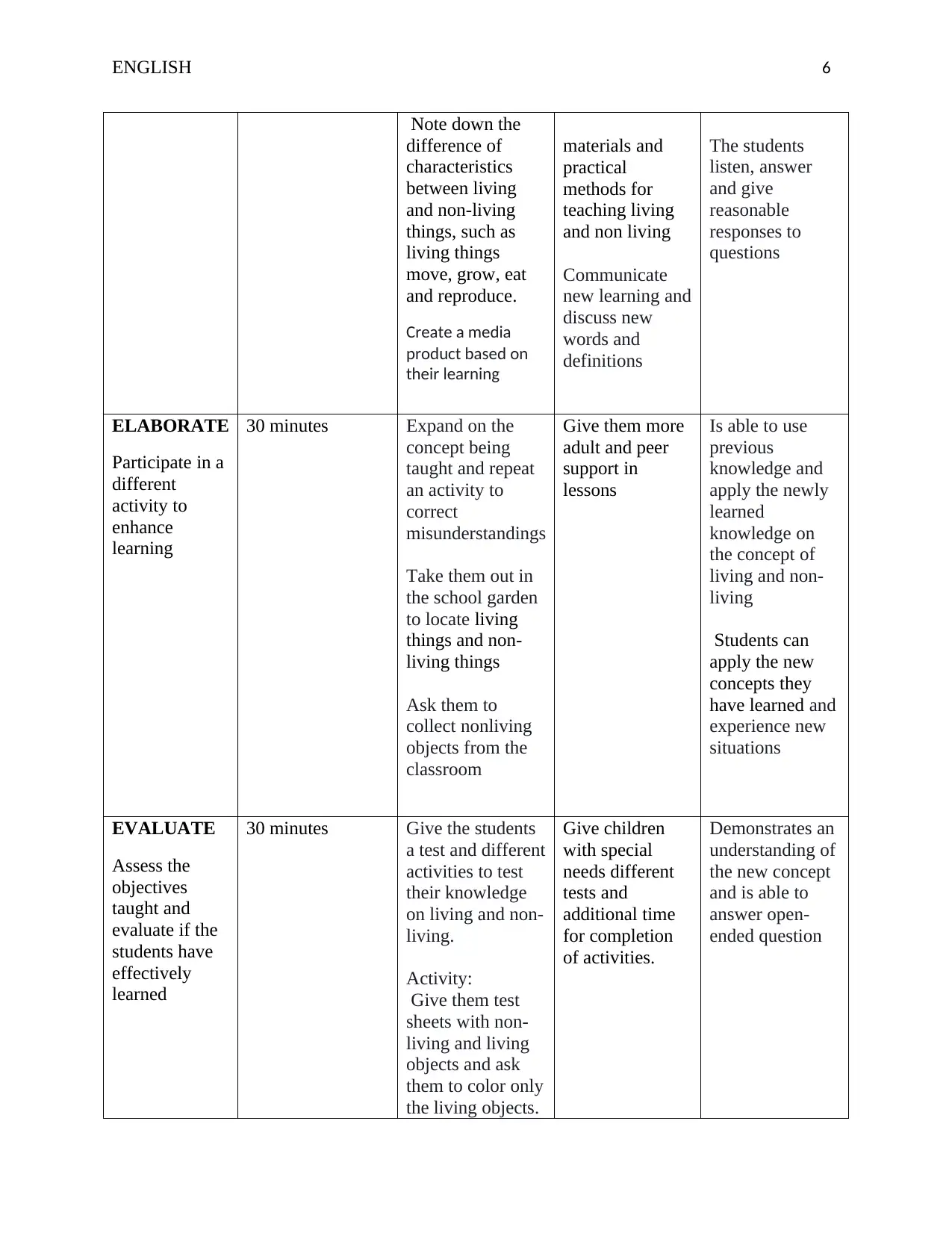
ENGLISH 6
Note down the
difference of
characteristics
between living
and non-living
things, such as
living things
move, grow, eat
and reproduce.
Create a media
product based on
their learning
materials and
practical
methods for
teaching living
and non living
Communicate
new learning and
discuss new
words and
definitions
The students
listen, answer
and give
reasonable
responses to
questions
ELABORATE
Participate in a
different
activity to
enhance
learning
30 minutes Expand on the
concept being
taught and repeat
an activity to
correct
misunderstandings
Take them out in
the school garden
to locate living
things and non-
living things
Ask them to
collect nonliving
objects from the
classroom
Give them more
adult and peer
support in
lessons
Is able to use
previous
knowledge and
apply the newly
learned
knowledge on
the concept of
living and non-
living
Students can
apply the new
concepts they
have learned and
experience new
situations
EVALUATE
Assess the
objectives
taught and
evaluate if the
students have
effectively
learned
30 minutes Give the students
a test and different
activities to test
their knowledge
on living and non-
living.
Activity:
Give them test
sheets with non-
living and living
objects and ask
them to color only
the living objects.
Give children
with special
needs different
tests and
additional time
for completion
of activities.
Demonstrates an
understanding of
the new concept
and is able to
answer open-
ended question
Note down the
difference of
characteristics
between living
and non-living
things, such as
living things
move, grow, eat
and reproduce.
Create a media
product based on
their learning
materials and
practical
methods for
teaching living
and non living
Communicate
new learning and
discuss new
words and
definitions
The students
listen, answer
and give
reasonable
responses to
questions
ELABORATE
Participate in a
different
activity to
enhance
learning
30 minutes Expand on the
concept being
taught and repeat
an activity to
correct
misunderstandings
Take them out in
the school garden
to locate living
things and non-
living things
Ask them to
collect nonliving
objects from the
classroom
Give them more
adult and peer
support in
lessons
Is able to use
previous
knowledge and
apply the newly
learned
knowledge on
the concept of
living and non-
living
Students can
apply the new
concepts they
have learned and
experience new
situations
EVALUATE
Assess the
objectives
taught and
evaluate if the
students have
effectively
learned
30 minutes Give the students
a test and different
activities to test
their knowledge
on living and non-
living.
Activity:
Give them test
sheets with non-
living and living
objects and ask
them to color only
the living objects.
Give children
with special
needs different
tests and
additional time
for completion
of activities.
Demonstrates an
understanding of
the new concept
and is able to
answer open-
ended question
⊘ This is a preview!⊘
Do you want full access?
Subscribe today to unlock all pages.

Trusted by 1+ million students worldwide
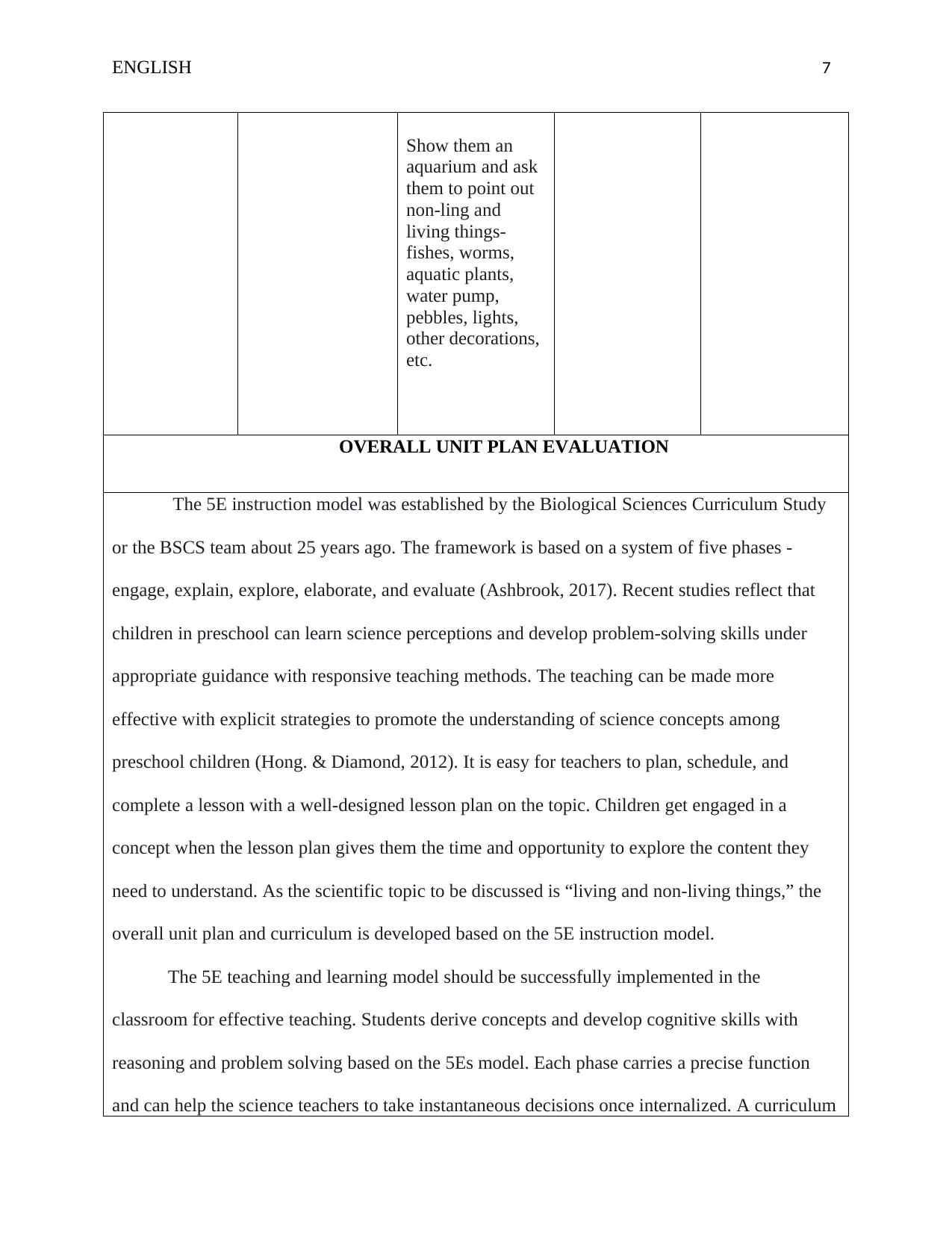
ENGLISH 7
Show them an
aquarium and ask
them to point out
non-ling and
living things-
fishes, worms,
aquatic plants,
water pump,
pebbles, lights,
other decorations,
etc.
OVERALL UNIT PLAN EVALUATION
The 5E instruction model was established by the Biological Sciences Curriculum Study
or the BSCS team about 25 years ago. The framework is based on a system of five phases -
engage, explain, explore, elaborate, and evaluate (Ashbrook, 2017). Recent studies reflect that
children in preschool can learn science perceptions and develop problem-solving skills under
appropriate guidance with responsive teaching methods. The teaching can be made more
effective with explicit strategies to promote the understanding of science concepts among
preschool children (Hong. & Diamond, 2012). It is easy for teachers to plan, schedule, and
complete a lesson with a well-designed lesson plan on the topic. Children get engaged in a
concept when the lesson plan gives them the time and opportunity to explore the content they
need to understand. As the scientific topic to be discussed is “living and non-living things,” the
overall unit plan and curriculum is developed based on the 5E instruction model.
The 5E teaching and learning model should be successfully implemented in the
classroom for effective teaching. Students derive concepts and develop cognitive skills with
reasoning and problem solving based on the 5Es model. Each phase carries a precise function
and can help the science teachers to take instantaneous decisions once internalized. A curriculum
Show them an
aquarium and ask
them to point out
non-ling and
living things-
fishes, worms,
aquatic plants,
water pump,
pebbles, lights,
other decorations,
etc.
OVERALL UNIT PLAN EVALUATION
The 5E instruction model was established by the Biological Sciences Curriculum Study
or the BSCS team about 25 years ago. The framework is based on a system of five phases -
engage, explain, explore, elaborate, and evaluate (Ashbrook, 2017). Recent studies reflect that
children in preschool can learn science perceptions and develop problem-solving skills under
appropriate guidance with responsive teaching methods. The teaching can be made more
effective with explicit strategies to promote the understanding of science concepts among
preschool children (Hong. & Diamond, 2012). It is easy for teachers to plan, schedule, and
complete a lesson with a well-designed lesson plan on the topic. Children get engaged in a
concept when the lesson plan gives them the time and opportunity to explore the content they
need to understand. As the scientific topic to be discussed is “living and non-living things,” the
overall unit plan and curriculum is developed based on the 5E instruction model.
The 5E teaching and learning model should be successfully implemented in the
classroom for effective teaching. Students derive concepts and develop cognitive skills with
reasoning and problem solving based on the 5Es model. Each phase carries a precise function
and can help the science teachers to take instantaneous decisions once internalized. A curriculum
Paraphrase This Document
Need a fresh take? Get an instant paraphrase of this document with our AI Paraphraser
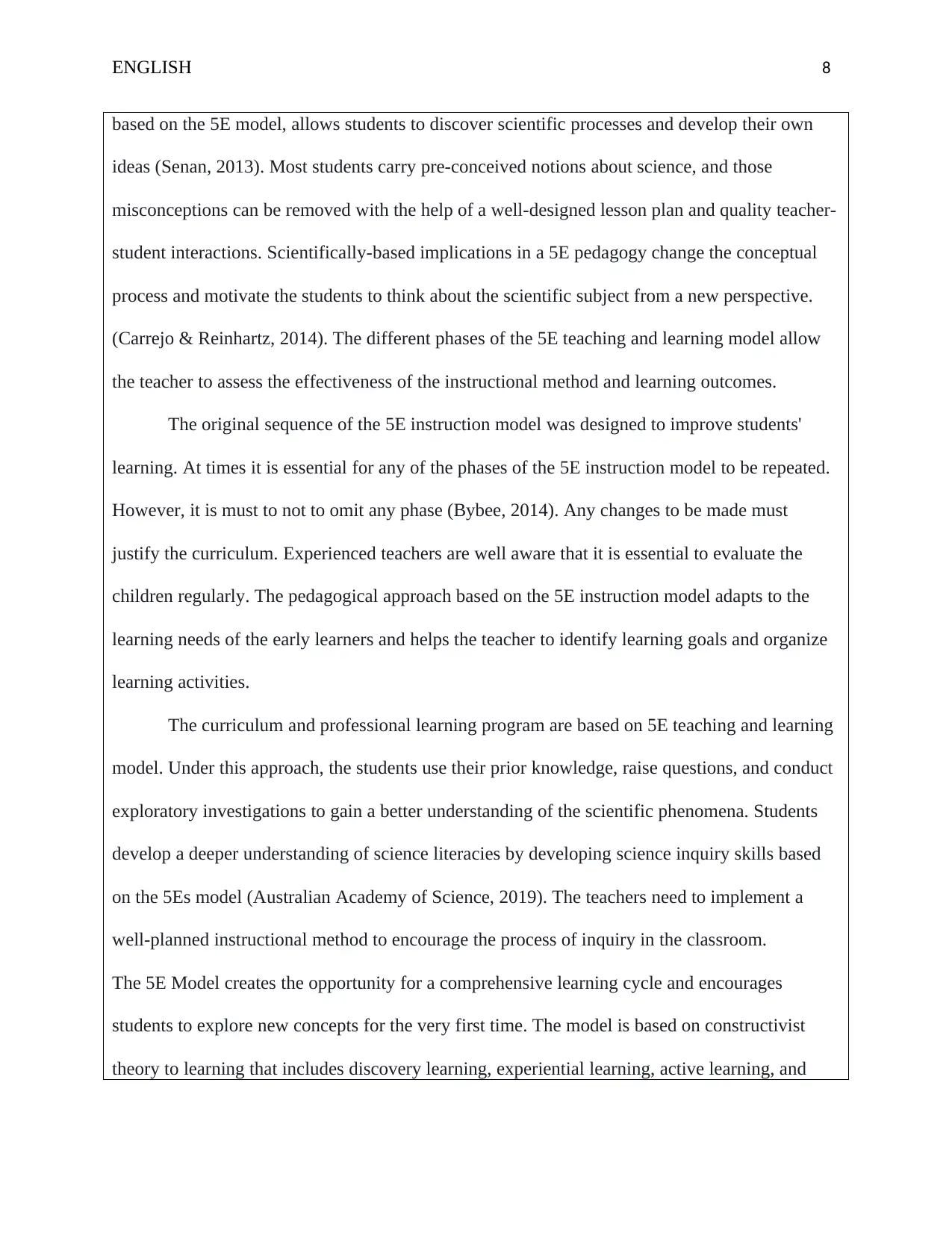
ENGLISH 8
based on the 5E model, allows students to discover scientific processes and develop their own
ideas (Senan, 2013). Most students carry pre-conceived notions about science, and those
misconceptions can be removed with the help of a well-designed lesson plan and quality teacher-
student interactions. Scientifically-based implications in a 5E pedagogy change the conceptual
process and motivate the students to think about the scientific subject from a new perspective.
(Carrejo & Reinhartz, 2014). The different phases of the 5E teaching and learning model allow
the teacher to assess the effectiveness of the instructional method and learning outcomes.
The original sequence of the 5E instruction model was designed to improve students'
learning. At times it is essential for any of the phases of the 5E instruction model to be repeated.
However, it is must to not to omit any phase (Bybee, 2014). Any changes to be made must
justify the curriculum. Experienced teachers are well aware that it is essential to evaluate the
children regularly. The pedagogical approach based on the 5E instruction model adapts to the
learning needs of the early learners and helps the teacher to identify learning goals and organize
learning activities.
The curriculum and professional learning program are based on 5E teaching and learning
model. Under this approach, the students use their prior knowledge, raise questions, and conduct
exploratory investigations to gain a better understanding of the scientific phenomena. Students
develop a deeper understanding of science literacies by developing science inquiry skills based
on the 5Es model (Australian Academy of Science, 2019). The teachers need to implement a
well-planned instructional method to encourage the process of inquiry in the classroom.
The 5E Model creates the opportunity for a comprehensive learning cycle and encourages
students to explore new concepts for the very first time. The model is based on constructivist
theory to learning that includes discovery learning, experiential learning, active learning, and
based on the 5E model, allows students to discover scientific processes and develop their own
ideas (Senan, 2013). Most students carry pre-conceived notions about science, and those
misconceptions can be removed with the help of a well-designed lesson plan and quality teacher-
student interactions. Scientifically-based implications in a 5E pedagogy change the conceptual
process and motivate the students to think about the scientific subject from a new perspective.
(Carrejo & Reinhartz, 2014). The different phases of the 5E teaching and learning model allow
the teacher to assess the effectiveness of the instructional method and learning outcomes.
The original sequence of the 5E instruction model was designed to improve students'
learning. At times it is essential for any of the phases of the 5E instruction model to be repeated.
However, it is must to not to omit any phase (Bybee, 2014). Any changes to be made must
justify the curriculum. Experienced teachers are well aware that it is essential to evaluate the
children regularly. The pedagogical approach based on the 5E instruction model adapts to the
learning needs of the early learners and helps the teacher to identify learning goals and organize
learning activities.
The curriculum and professional learning program are based on 5E teaching and learning
model. Under this approach, the students use their prior knowledge, raise questions, and conduct
exploratory investigations to gain a better understanding of the scientific phenomena. Students
develop a deeper understanding of science literacies by developing science inquiry skills based
on the 5Es model (Australian Academy of Science, 2019). The teachers need to implement a
well-planned instructional method to encourage the process of inquiry in the classroom.
The 5E Model creates the opportunity for a comprehensive learning cycle and encourages
students to explore new concepts for the very first time. The model is based on constructivist
theory to learning that includes discovery learning, experiential learning, active learning, and
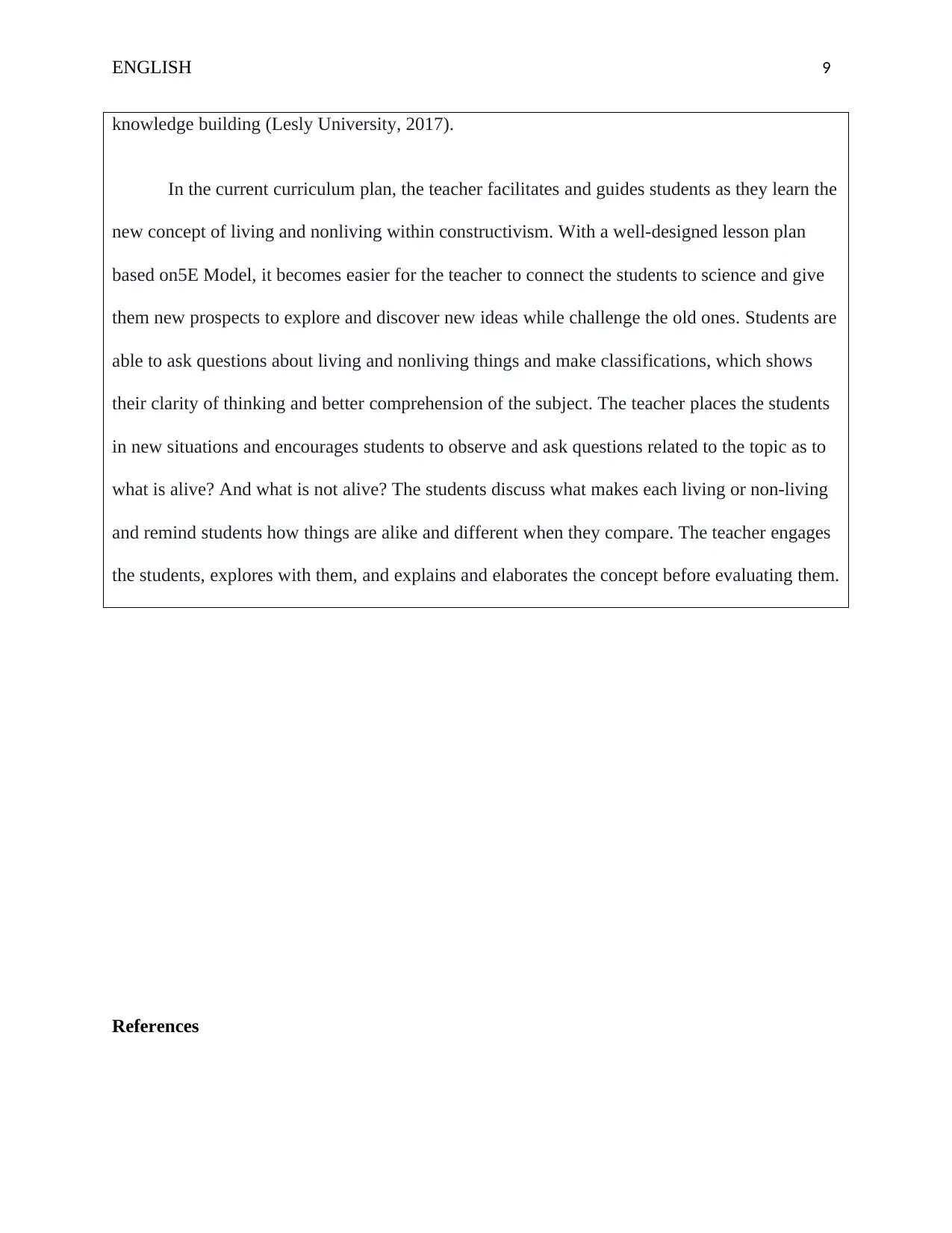
ENGLISH 9
knowledge building (Lesly University, 2017).
In the current curriculum plan, the teacher facilitates and guides students as they learn the
new concept of living and nonliving within constructivism. With a well-designed lesson plan
based on5E Model, it becomes easier for the teacher to connect the students to science and give
them new prospects to explore and discover new ideas while challenge the old ones. Students are
able to ask questions about living and nonliving things and make classifications, which shows
their clarity of thinking and better comprehension of the subject. The teacher places the students
in new situations and encourages students to observe and ask questions related to the topic as to
what is alive? And what is not alive? The students discuss what makes each living or non-living
and remind students how things are alike and different when they compare. The teacher engages
the students, explores with them, and explains and elaborates the concept before evaluating them.
References
knowledge building (Lesly University, 2017).
In the current curriculum plan, the teacher facilitates and guides students as they learn the
new concept of living and nonliving within constructivism. With a well-designed lesson plan
based on5E Model, it becomes easier for the teacher to connect the students to science and give
them new prospects to explore and discover new ideas while challenge the old ones. Students are
able to ask questions about living and nonliving things and make classifications, which shows
their clarity of thinking and better comprehension of the subject. The teacher places the students
in new situations and encourages students to observe and ask questions related to the topic as to
what is alive? And what is not alive? The students discuss what makes each living or non-living
and remind students how things are alike and different when they compare. The teacher engages
the students, explores with them, and explains and elaborates the concept before evaluating them.
References
⊘ This is a preview!⊘
Do you want full access?
Subscribe today to unlock all pages.

Trusted by 1+ million students worldwide
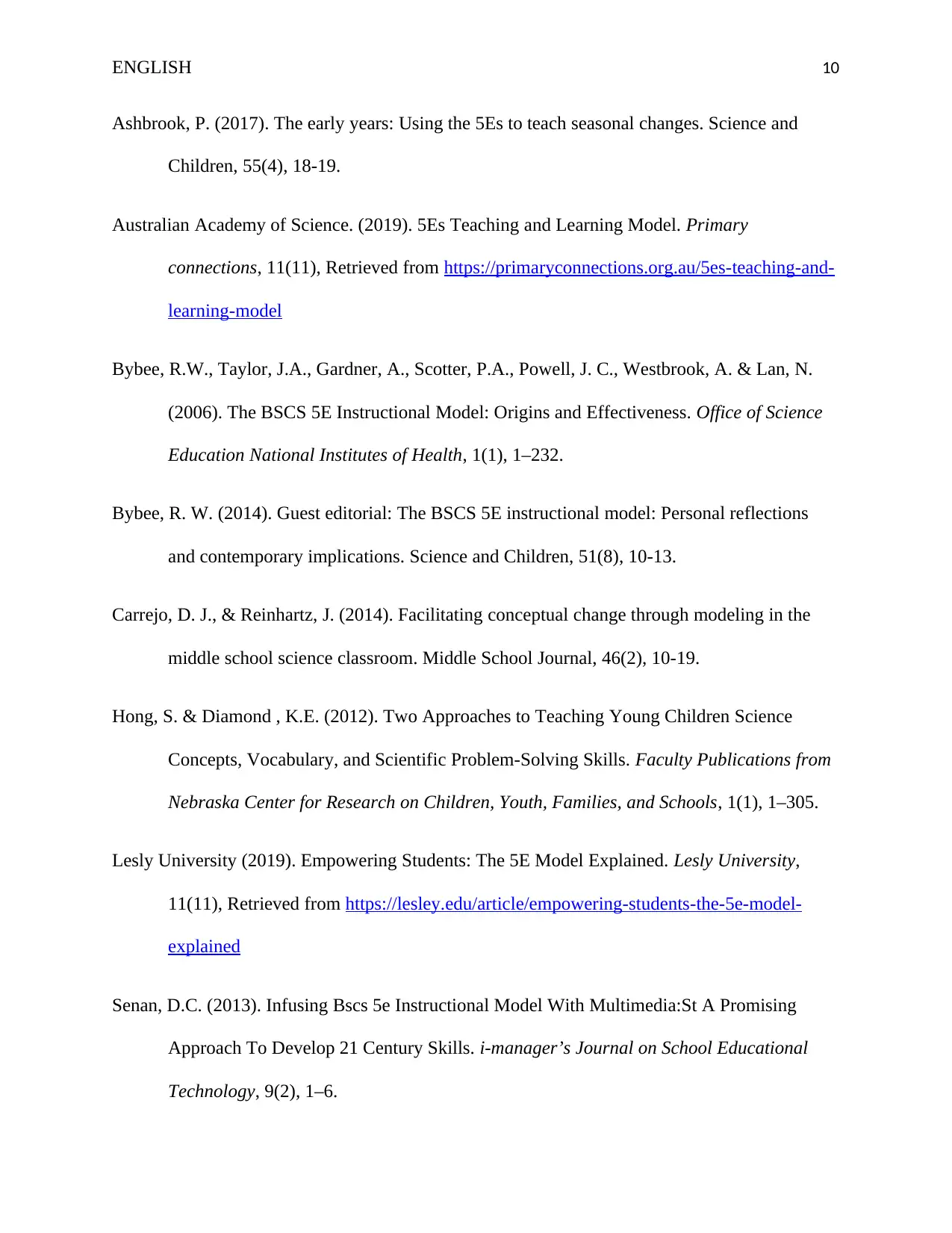
ENGLISH 10
Ashbrook, P. (2017). The early years: Using the 5Es to teach seasonal changes. Science and
Children, 55(4), 18-19.
Australian Academy of Science. (2019). 5Es Teaching and Learning Model. Primary
connections, 11(11), Retrieved from https://primaryconnections.org.au/5es-teaching-and-
learning-model
Bybee, R.W., Taylor, J.A., Gardner, A., Scotter, P.A., Powell, J. C., Westbrook, A. & Lan, N.
(2006). The BSCS 5E Instructional Model: Origins and Effectiveness. Office of Science
Education National Institutes of Health, 1(1), 1–232.
Bybee, R. W. (2014). Guest editorial: The BSCS 5E instructional model: Personal reflections
and contemporary implications. Science and Children, 51(8), 10-13.
Carrejo, D. J., & Reinhartz, J. (2014). Facilitating conceptual change through modeling in the
middle school science classroom. Middle School Journal, 46(2), 10-19.
Hong, S. & Diamond , K.E. (2012). Two Approaches to Teaching Young Children Science
Concepts, Vocabulary, and Scientific Problem-Solving Skills. Faculty Publications from
Nebraska Center for Research on Children, Youth, Families, and Schools, 1(1), 1–305.
Lesly University (2019). Empowering Students: The 5E Model Explained. Lesly University,
11(11), Retrieved from https://lesley.edu/article/empowering-students-the-5e-model-
explained
Senan, D.C. (2013). Infusing Bscs 5e Instructional Model With Multimedia:St A Promising
Approach To Develop 21 Century Skills. i-manager’s Journal on School Educational
Technology, 9(2), 1–6.
Ashbrook, P. (2017). The early years: Using the 5Es to teach seasonal changes. Science and
Children, 55(4), 18-19.
Australian Academy of Science. (2019). 5Es Teaching and Learning Model. Primary
connections, 11(11), Retrieved from https://primaryconnections.org.au/5es-teaching-and-
learning-model
Bybee, R.W., Taylor, J.A., Gardner, A., Scotter, P.A., Powell, J. C., Westbrook, A. & Lan, N.
(2006). The BSCS 5E Instructional Model: Origins and Effectiveness. Office of Science
Education National Institutes of Health, 1(1), 1–232.
Bybee, R. W. (2014). Guest editorial: The BSCS 5E instructional model: Personal reflections
and contemporary implications. Science and Children, 51(8), 10-13.
Carrejo, D. J., & Reinhartz, J. (2014). Facilitating conceptual change through modeling in the
middle school science classroom. Middle School Journal, 46(2), 10-19.
Hong, S. & Diamond , K.E. (2012). Two Approaches to Teaching Young Children Science
Concepts, Vocabulary, and Scientific Problem-Solving Skills. Faculty Publications from
Nebraska Center for Research on Children, Youth, Families, and Schools, 1(1), 1–305.
Lesly University (2019). Empowering Students: The 5E Model Explained. Lesly University,
11(11), Retrieved from https://lesley.edu/article/empowering-students-the-5e-model-
explained
Senan, D.C. (2013). Infusing Bscs 5e Instructional Model With Multimedia:St A Promising
Approach To Develop 21 Century Skills. i-manager’s Journal on School Educational
Technology, 9(2), 1–6.
Paraphrase This Document
Need a fresh take? Get an instant paraphrase of this document with our AI Paraphraser

ENGLISH 11
1 out of 11
Related Documents
Your All-in-One AI-Powered Toolkit for Academic Success.
+13062052269
info@desklib.com
Available 24*7 on WhatsApp / Email
![[object Object]](/_next/static/media/star-bottom.7253800d.svg)
Unlock your academic potential
Copyright © 2020–2025 A2Z Services. All Rights Reserved. Developed and managed by ZUCOL.





